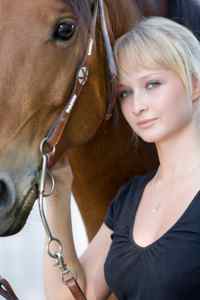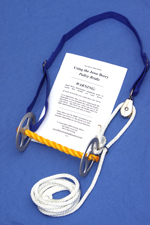 “Is Your Horse Half-Brained?”
“Is Your Horse Half-Brained?”
I remember being called ‘half brain’ when I was younger.
The reason for that was my ‘not so smart moments’ in life like when I forgot to shut the front door as I left the house or a dozen other things.
[With my kids in the 12 – 18 year old range I call it the “teenage minds of mush” syndrome. Relate?]
Believe it or not, horses are half brained much of the time and it can work against you if you’re not aware of it.
Here’s what I mean.
As you know, horses have an eye on each side of their head.
The right eye can see what’s going on towards the front of him, to his right, and behind him on the right.
His left eye takes care of the other side.
Thus, one eye can see what’s happening on one side of his body ‘independently’ of the other eye.
Us humans do not have that ability.
Do you know what that means?
That means ‘half’ of his attention is assigned to one eye. The other half of his attention is assigned to the other eye.
That means half of his brain is with one eye and the other half is with the other eye.
Why is that important?
Because when you’re working with your horse and you’ve only got one of his eyes on you…
You Only Have
Half Of His Attention!
If you don’t have his attention, you don’t have the horse.
What’s curious to me is a lot of people don’t understand this. Or if they do, they don’t seem to mind the horse doesn’t give them full attention.
But it’s crucial to have it if you’re going to teach your horse something.
Not only that, I find it totally disrespectful to NOT have someone’s attention when I’m talking – and that goes for horses too!
Have you ever had a conversation with someone and as you talk they look away, or act uninterested, or keep looking at their watch?
That’s rude!
Although I can’t do much about a person being rude, I certainly can with a horse.
And when a horse isn’t giving me his attention, it’s rude.
After all, I’m not asking them to give it to me all day.
They have 23 hours a day to eat, meander, run, etc….but when it’s my time – I want ’em giving me attention.
And if I only get one eye, then I’m not getting ALL their attention.
Now there are many times you won’t always get both eyes.
After all, if you’re lungeing a horse you’ll only get one eye because he’s circling around you.
BUT!!!
He can still focus most of his attention on you while lungeing.
And he should.
But remember, a horse’s attention span isn’t all that long and they have to be reminded to give it to you.
The younger the horse, the shorter the attention span. (Generally speaking)
How do you get your horse’s attention back on you if you lose it?
Make ’em move.
Create a little pressure.
Now why is this important?
Well, a horse ignoring you is bad manners for the horse.
A horse, like kids, must have good manners. Giving you attention is part of good manners.
But also, to train a horse you must have his attention.
If he’s going to be responsive to what you ask him to do, you have to have his attention.
What I just told you about how the horse’s brain works and how getting both eyes gives you both sides of his brain…which gives you his attention… is a significant part of understanding the horse.
If you have ever wondered to yourself, ‘Why does my horse do X ? ‘, then it may be there’s something about his nature you don’t know…but should.
In all my encounters with horse trainers, there’s one thing (among others) that we consistently agree on.
And that is…
‘To be successful with horses, you must understand their nature.’
Makes sense, really.
After all, if you’re going to be a surgeon, you must know how the body works so you can repair damage and keep it working.
If you’re going to be an auto mechanic, you must know how engines work to fix them.
If you make engine repairs that are inconsistent with how an engine works, you will fail.
Training your horse is much the same way.
You MUST know how it works, thinks, acts, reacts, and so on.
There are lots of books on the subject if you want to read and study up on it.
Jesse Beery figured this our real early when he was learning horse training and developing his training methods. You can see more about his training course here:
http://horsetrainingresources.
Or, you can take advantage of many of our excellent training videos by one of our professional trainers here:
http://horsetrainingresources.
Remember…
The more you know about your horse, the better you’ll be.
That’s the big difference between people who are mildly successful versus those who can get their horses doing amazing things.
Knowledge.
It begins with understanding the nature of your horse.
Ok… that’s it.
Stay safe out there with your horses.
Charlie


